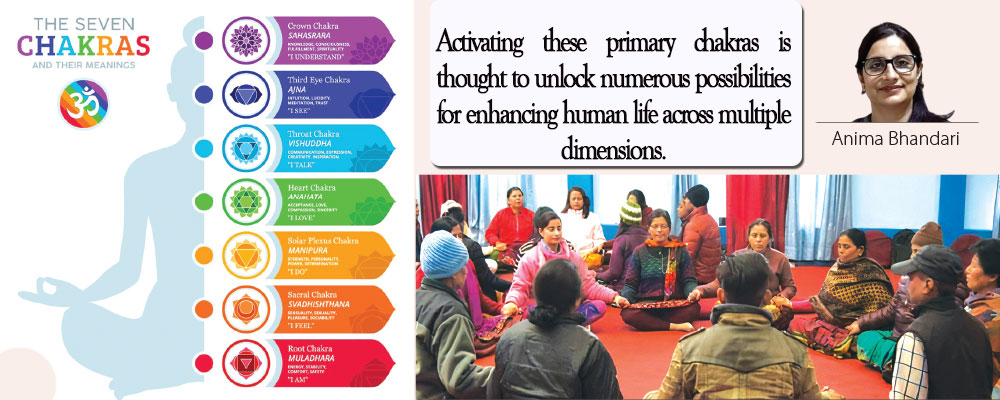- Monday, 8 September 2025
Activating Body Chakras To Re-energise Life
Are you familiar with the concept of chakras, or energy points within the human body? Actually, the word chakra, originating from Sanskrit meaning "wheel" or "disc," is believed to refer to spinning centres of energy located along the spine. They are intricately linked to various aspects of physical, emotional, and spiritual well-being. While there are 114 chakras within the human body, with some extending beyond its physical bounds, the primary focus often centres on the seven major chakras. Activating these primary chakras is thought to unlock numerous possibilities for enhancing human life across multiple dimensions. Following is the introduction of seven key body chakras and their essence:
Muladhara chakra
Positioned at the base of the spine, the Muladhara, or root chakra, is connected with the physical body, including the formation of bones and muscles, and is closely tied to overall physical health. It is closely linked to feelings of groundedness, stability, security, and survival instincts. Aligned with the earth element, or Prithivi Tatwa, among the five elements, activation of the root chakra raises an active lifestyle, a readiness to assist others, physical fitness, and a passion for work. Imbalances in the root chakra may manifest as laziness, dependence on others for tasks, physical weakness, and fluctuations in body weight.
Swadhisthana chakra
Located in the lower abdomen, just beneath the navel, the Swadhisthana, or sacral chakra, is connected to emotions, creativity, pleasure, and sexuality. It plays an essential role in our capacity to experience joy, passion, and intimacy. Aligned with the water element, or Jal Tatwa, within the human body, this chakra aids in balancing and regulating the water element, including blood and bodily fluids. When functioning harmoniously, it encourages a healthy expression of emotions and fosters creativity, leading to a positive outlook on life and an appreciation for its beauty. However, imbalances in this chakra can disrupt emotional stability, intimacy, and creative expression. Individuals may experience an increase in negative emotions, self-criticism, and a lack of self-love or love for others, potentially leading to depression or even thoughts of ending their own lives. Furthermore, chakra imbalances may give rise to illnesses affecting the lower abdomen and sexual organs.
Manipur chakra
Situated in the upper abdomen, just above the navel, the Manipur or solar plexus chakra is intricately linked with personal power, self-esteem, willpower, and confidence. It plays a significant role in shaping our sense of self-worth and our capacity to assert ourselves in the world. Aligned with the fire element, or Agni Tatwa, among the five elements, this chakra embodies qualities of strength, empowerment, and courage. A balanced solar plexus chakra raises a robust sense of self and empowerment, along with confidence and a willingness to take risks. Individuals may feel capable and optimistic about their endeavours, with a strong belief in their ability to achieve their goals. Conversely, imbalances in this chakra can lead to feelings of insecurity, low self-esteem, or a lack of direction, resulting in a sense of helplessness or a belief that success is unattainable. Additionally, imbalances may contribute to illnesses affecting the abdomen area.
Anahata chakra
Located at the centre of the chest, the Anahata, or heart chakra, is deeply connected to emotions such as love, compassion, forgiveness, and interpersonal connections. It plays an essential role in our capacity to both give and receive love, extending it not only to others but also to ourselves. A harmonious heart chakra adopts qualities of empathy, compassion, and the cultivation of healthy relationships. However, imbalances in this chakra can lead to challenges such as trust issues, emotional distress, or difficulties in forming meaningful connections. These imbalances may result in the breakdown of relationships, increased tendencies towards cruelty or rudeness, and a general sense of disconnection. Associated with the air element, or Bayu Tatwa, among the five elements, this chakra aids in balancing the air elements within the body. Imbalances in the heart chakra may contribute to illnesses affecting the chest area.
Vishuddhi chakra
Situated in the region of the throat, the Vishuddi, or throat chakra, is intricately linked with communication, self-expression, truth, and authenticity. It serves as the conduit for our ability to express ourselves clearly and sincerely, whether through spoken words or non-verbal signals. Additionally, it holds significance as the centre of knowledge and is associated with the goddess Saraswati. A well-balanced throat chakra facilitates effective communication and genuine self-expression, enhancing our understanding of both ourselves and others, fostering knowledge acquisition, sharpening memory recall, and promoting clarity in our interactions. However, imbalances in this chakra may manifest as difficulties in speaking one's truth, fear of judgement, or communication challenges, leading to an inability to express oneself effectively and a decline in memory power. Associated with the sky element, or Aakash Tatwo, among the five elements, imbalances in the throat chakra may contribute to throat-related illnesses and thyroid issues.
Aagya chakra
Located between the eyebrows, the aagya, or third eye chakra, is intricately linked with intuition, insight, perception, willpower, decision-making ability, and spiritual awareness. It serves as the centre of inner wisdom, enabling us to perceive beyond the limits of the physical kingdom. A harmonious third-eye chakra enriches our intuition, fosters clarity of thought, and deepens our spiritual connection. However, imbalances in this chakra may result in feelings of confusion, a lack of clarity, or challenges in trusting one's intuition.
Sahasrara chakra
Positioned at the pinnacle of the head, the Sahasrara, or crown chakra, is intricately linked with consciousness, spirituality, enlightenment, and a divine connection. It symbolises our highest self and our inherent connection to the universe, or a higher power. When in equilibrium, the crown chakra fosters spiritual evolution, inner tranquilly, and a profound sense of unity with the cosmos. However, imbalances in this chakra may give rise to feelings of detachment, spiritual turmoil, or existential dilemmas.
As humans, we have the capability to activate our chakras and unlock a wide range of human potential. While methods for activating these chakras can be found in various mediums, such as books and social media platforms, it is advisable not to attempt these practices independently. Instead, it is recommended to seek guidance from an experienced teacher or guru when engaging in chakra activation exercises.
As humans, we have the potential to activate our chakras, unlocking a broad range of human capabilities. From a scientific standpoint, the practice of yoga and meditation can promote the health of both the body and mind. Achieving complete health requires each organ to function optimally. A healthy body and mind release neurotransmitters and hormones such as serotonin, dopamine, endorphins, and oxytocin, which facilitate physical and mental well-being and contribute to achieving happiness and success in all aspects of life, both physical and spiritual.
On March 30, 2024, Jeevan Vigyan, a spiritual organisation, is set to host an immersive 8-day Virat Chakra Vigyan meditation (healing and activating) programme in Lumbini, the birthplace of Buddha. Approximately 5,000 individuals are expected to participate in this event. Notably, there has been no previous instance recorded of such a large gathering meditating together at a single location, potentially making it an entry into the Guinness Book of World Records.
(The author is the Kantipath Branch Manager of NABIL Bank.)





-square-thumb.jpg)



-original-thumb.jpg)



-original-thumb.jpg)



